Literature Review: Effective Supplier Integration Mechanisms in IORs
VerifiedAdded on 2023/01/13
|17
|4004
|25
Literature Review
AI Summary
This literature review critically investigates the theoretical background and research results concerning effective supplier integration mechanisms in inter-organizational projects. It examines organizational relations, models of intra-organizational integration, supplier relationship management trends, supply chain integration (SCI), information flow, and inter-organizational relations (IORs), including traditional and electronic forms. The review covers types of supplier integration, the supplier's role in new product development, structural characteristics of the purchasing organization, and collaborative processes like VMI and CPFR. Key inter-organizational theories are discussed, including context-based models of intra-organizational integration and the importance of information flow in IORs. The report also analyzes research results on collaboration, technology transfer, and partnership sourcing, providing a comprehensive overview of the rationale behind effective supplier integration. The review highlights the significance of supplier knowledge, strategic procurement, and the impact of IORs on supply chain performance. It emphasizes the role of suppliers in new product development and changing perspectives in procurement practices.
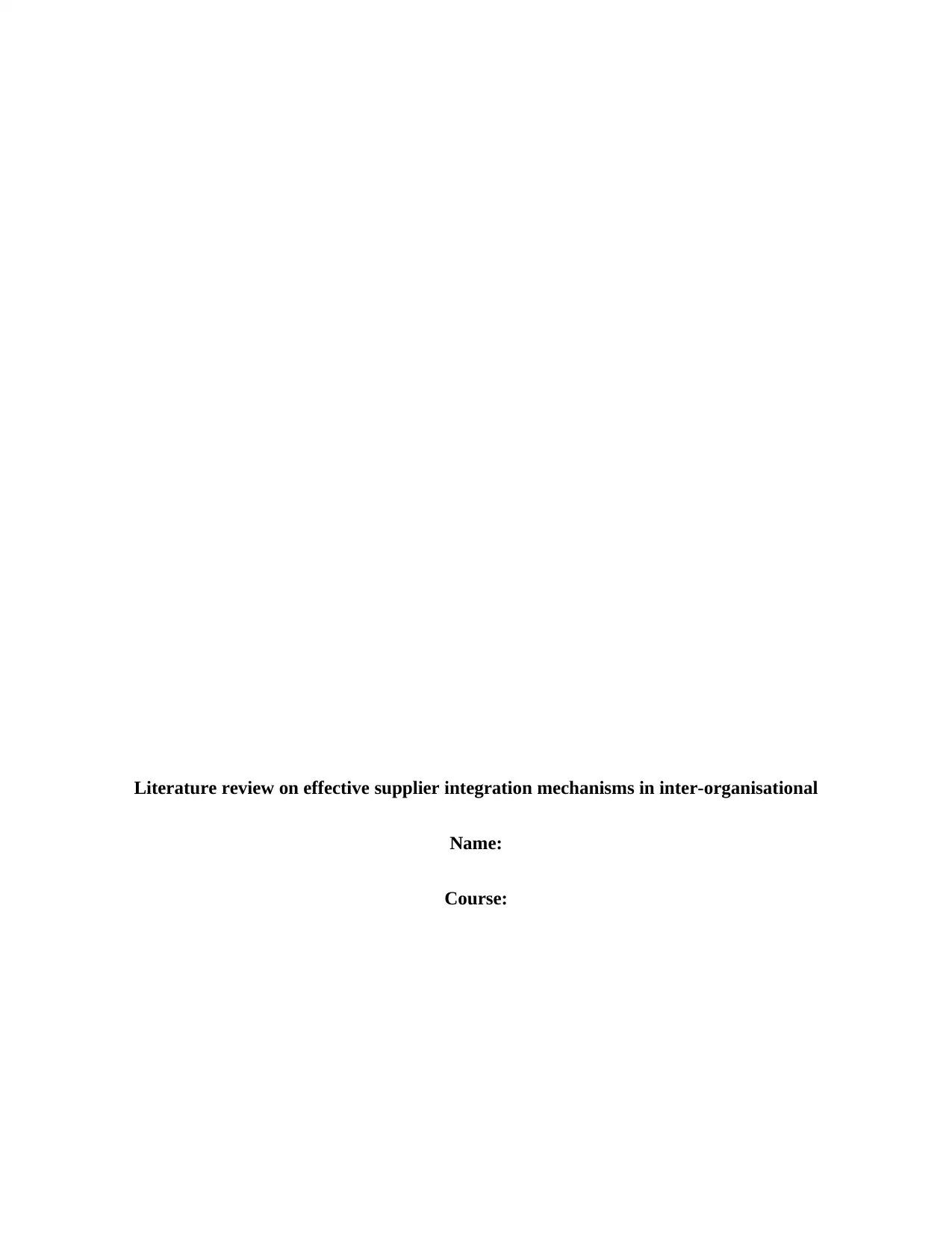
Literature review on effective supplier integration mechanisms in inter-organisational
Name:
Course:
Name:
Course:
Paraphrase This Document
Need a fresh take? Get an instant paraphrase of this document with our AI Paraphraser
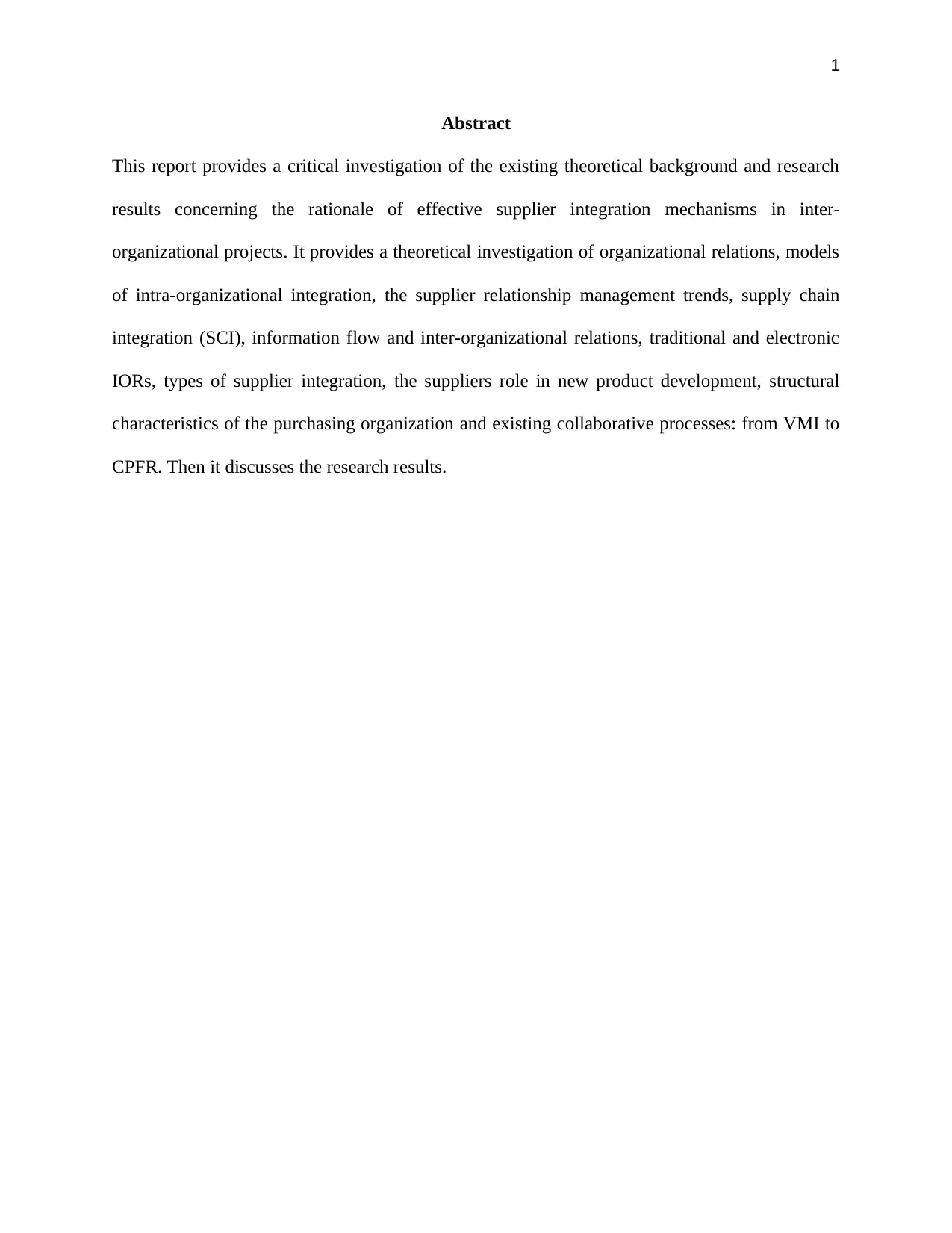
1
Abstract
This report provides a critical investigation of the existing theoretical background and research
results concerning the rationale of effective supplier integration mechanisms in inter-
organizational projects. It provides a theoretical investigation of organizational relations, models
of intra-organizational integration, the supplier relationship management trends, supply chain
integration (SCI), information flow and inter-organizational relations, traditional and electronic
IORs, types of supplier integration, the suppliers role in new product development, structural
characteristics of the purchasing organization and existing collaborative processes: from VMI to
CPFR. Then it discusses the research results.
Abstract
This report provides a critical investigation of the existing theoretical background and research
results concerning the rationale of effective supplier integration mechanisms in inter-
organizational projects. It provides a theoretical investigation of organizational relations, models
of intra-organizational integration, the supplier relationship management trends, supply chain
integration (SCI), information flow and inter-organizational relations, traditional and electronic
IORs, types of supplier integration, the suppliers role in new product development, structural
characteristics of the purchasing organization and existing collaborative processes: from VMI to
CPFR. Then it discusses the research results.
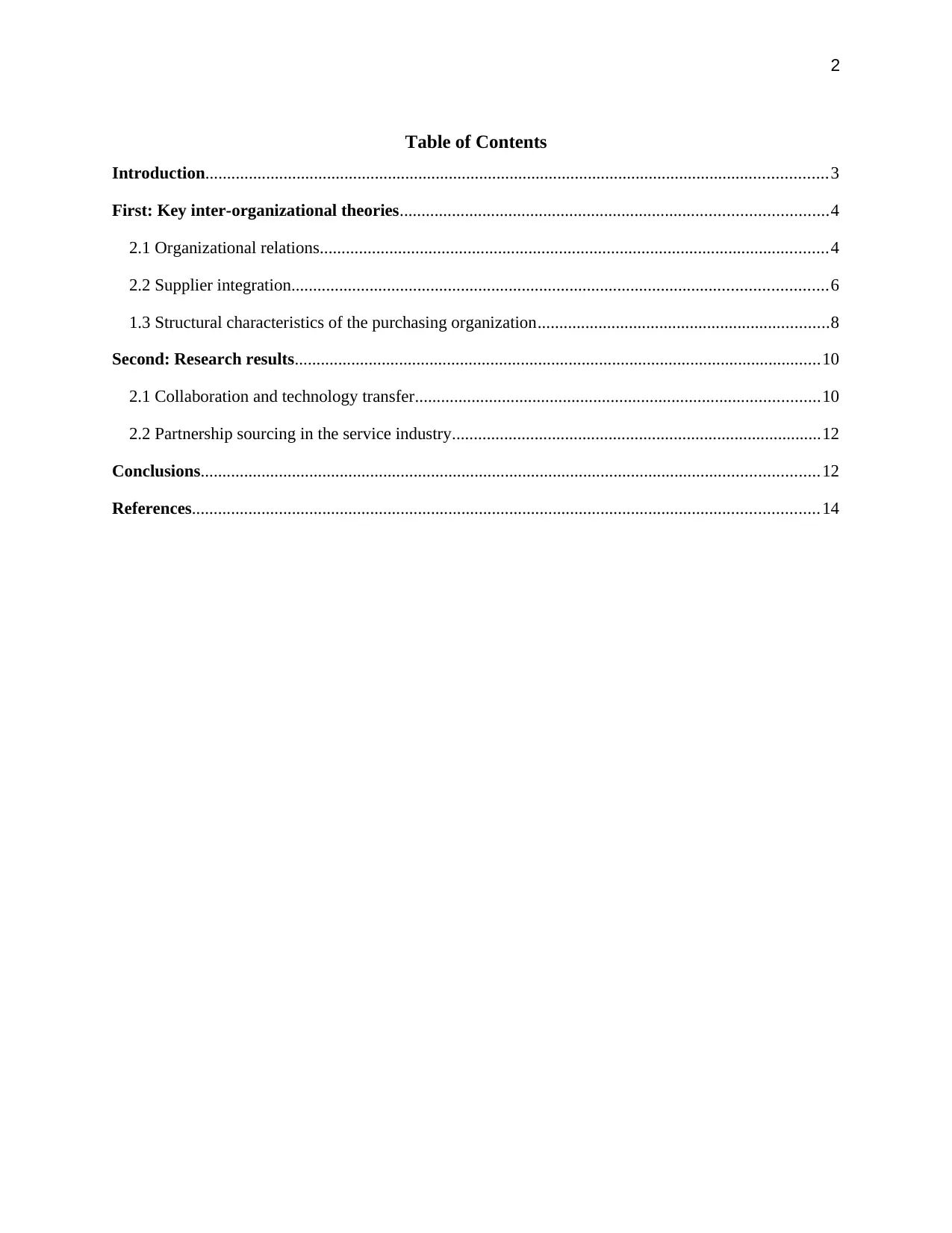
2
Table of Contents
Introduction...............................................................................................................................................3
First: Key inter-organizational theories..................................................................................................4
2.1 Organizational relations.....................................................................................................................4
2.2 Supplier integration...........................................................................................................................6
1.3 Structural characteristics of the purchasing organization...................................................................8
Second: Research results.........................................................................................................................10
2.1 Collaboration and technology transfer.............................................................................................10
2.2 Partnership sourcing in the service industry.....................................................................................12
Conclusions..............................................................................................................................................12
References................................................................................................................................................14
Table of Contents
Introduction...............................................................................................................................................3
First: Key inter-organizational theories..................................................................................................4
2.1 Organizational relations.....................................................................................................................4
2.2 Supplier integration...........................................................................................................................6
1.3 Structural characteristics of the purchasing organization...................................................................8
Second: Research results.........................................................................................................................10
2.1 Collaboration and technology transfer.............................................................................................10
2.2 Partnership sourcing in the service industry.....................................................................................12
Conclusions..............................................................................................................................................12
References................................................................................................................................................14
⊘ This is a preview!⊘
Do you want full access?
Subscribe today to unlock all pages.

Trusted by 1+ million students worldwide
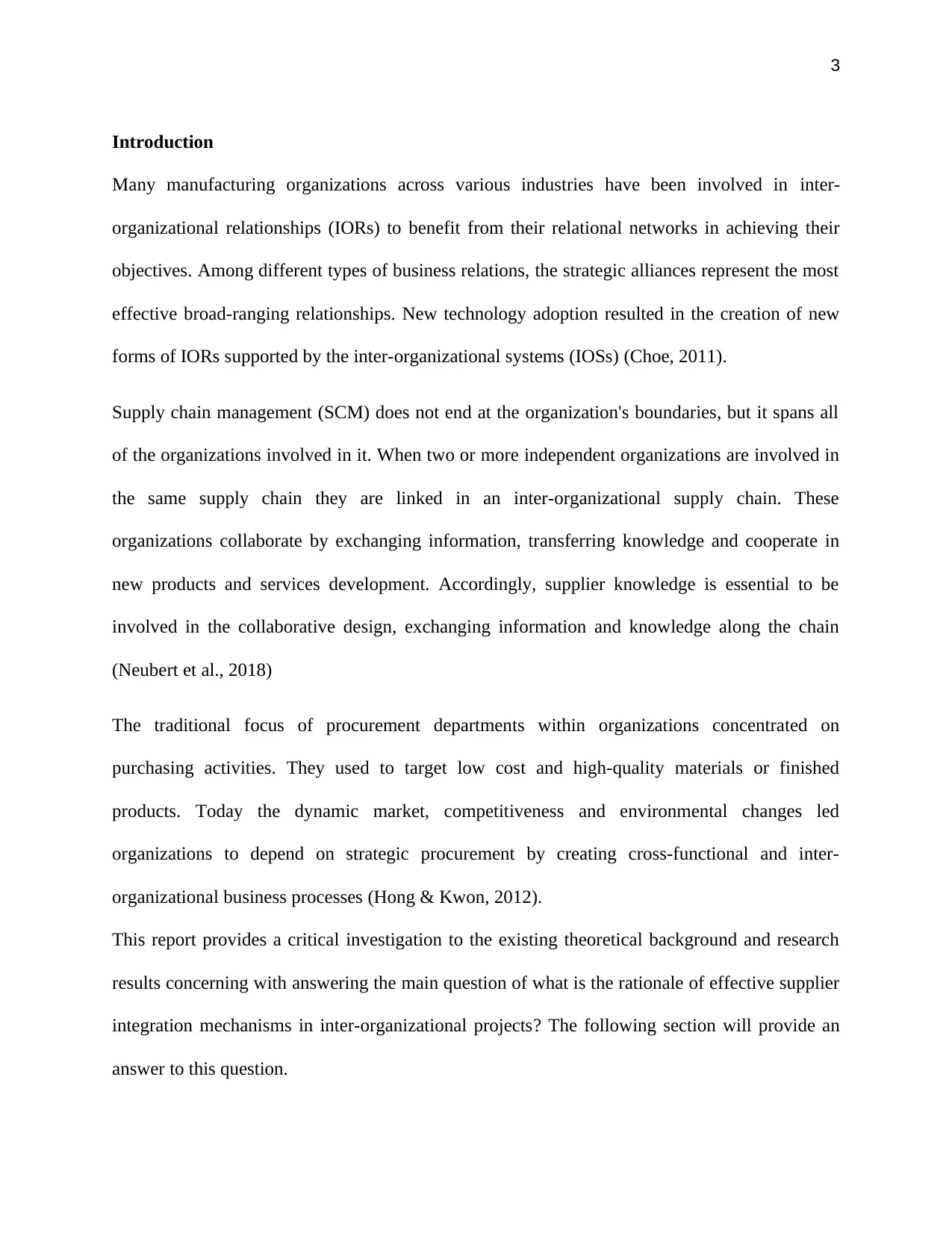
3
Introduction
Many manufacturing organizations across various industries have been involved in inter-
organizational relationships (IORs) to benefit from their relational networks in achieving their
objectives. Among different types of business relations, the strategic alliances represent the most
effective broad-ranging relationships. New technology adoption resulted in the creation of new
forms of IORs supported by the inter-organizational systems (IOSs) (Choe, 2011).
Supply chain management (SCM) does not end at the organization's boundaries, but it spans all
of the organizations involved in it. When two or more independent organizations are involved in
the same supply chain they are linked in an inter-organizational supply chain. These
organizations collaborate by exchanging information, transferring knowledge and cooperate in
new products and services development. Accordingly, supplier knowledge is essential to be
involved in the collaborative design, exchanging information and knowledge along the chain
(Neubert et al., 2018)
The traditional focus of procurement departments within organizations concentrated on
purchasing activities. They used to target low cost and high-quality materials or finished
products. Today the dynamic market, competitiveness and environmental changes led
organizations to depend on strategic procurement by creating cross-functional and inter-
organizational business processes (Hong & Kwon, 2012).
This report provides a critical investigation to the existing theoretical background and research
results concerning with answering the main question of what is the rationale of effective supplier
integration mechanisms in inter-organizational projects? The following section will provide an
answer to this question.
Introduction
Many manufacturing organizations across various industries have been involved in inter-
organizational relationships (IORs) to benefit from their relational networks in achieving their
objectives. Among different types of business relations, the strategic alliances represent the most
effective broad-ranging relationships. New technology adoption resulted in the creation of new
forms of IORs supported by the inter-organizational systems (IOSs) (Choe, 2011).
Supply chain management (SCM) does not end at the organization's boundaries, but it spans all
of the organizations involved in it. When two or more independent organizations are involved in
the same supply chain they are linked in an inter-organizational supply chain. These
organizations collaborate by exchanging information, transferring knowledge and cooperate in
new products and services development. Accordingly, supplier knowledge is essential to be
involved in the collaborative design, exchanging information and knowledge along the chain
(Neubert et al., 2018)
The traditional focus of procurement departments within organizations concentrated on
purchasing activities. They used to target low cost and high-quality materials or finished
products. Today the dynamic market, competitiveness and environmental changes led
organizations to depend on strategic procurement by creating cross-functional and inter-
organizational business processes (Hong & Kwon, 2012).
This report provides a critical investigation to the existing theoretical background and research
results concerning with answering the main question of what is the rationale of effective supplier
integration mechanisms in inter-organizational projects? The following section will provide an
answer to this question.
Paraphrase This Document
Need a fresh take? Get an instant paraphrase of this document with our AI Paraphraser
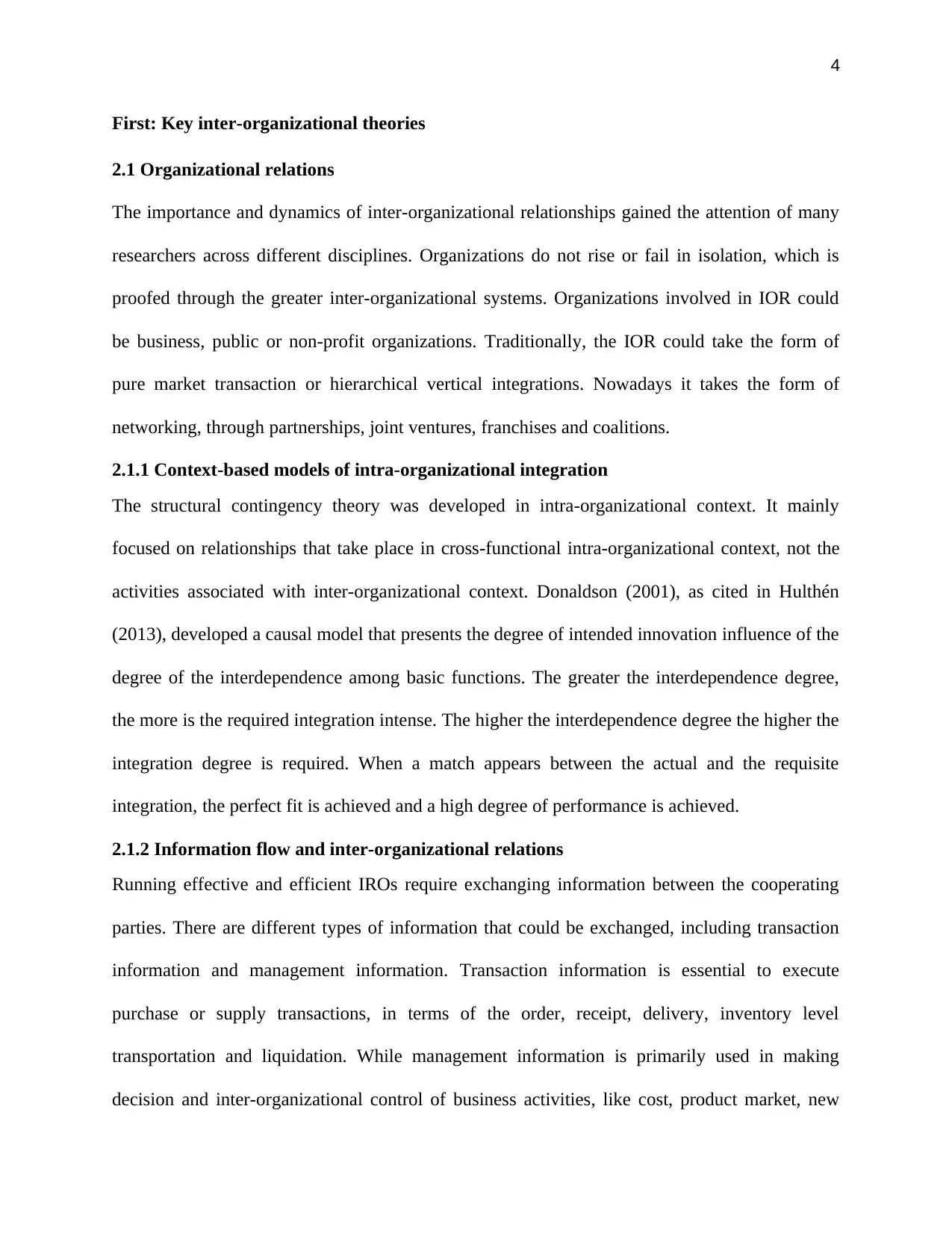
4
First: Key inter-organizational theories
2.1 Organizational relations
The importance and dynamics of inter-organizational relationships gained the attention of many
researchers across different disciplines. Organizations do not rise or fail in isolation, which is
proofed through the greater inter-organizational systems. Organizations involved in IOR could
be business, public or non-profit organizations. Traditionally, the IOR could take the form of
pure market transaction or hierarchical vertical integrations. Nowadays it takes the form of
networking, through partnerships, joint ventures, franchises and coalitions.
2.1.1 Context-based models of intra-organizational integration
The structural contingency theory was developed in intra-organizational context. It mainly
focused on relationships that take place in cross-functional intra-organizational context, not the
activities associated with inter-organizational context. Donaldson (2001), as cited in Hulthén
(2013), developed a causal model that presents the degree of intended innovation influence of the
degree of the interdependence among basic functions. The greater the interdependence degree,
the more is the required integration intense. The higher the interdependence degree the higher the
integration degree is required. When a match appears between the actual and the requisite
integration, the perfect fit is achieved and a high degree of performance is achieved.
2.1.2 Information flow and inter-organizational relations
Running effective and efficient IROs require exchanging information between the cooperating
parties. There are different types of information that could be exchanged, including transaction
information and management information. Transaction information is essential to execute
purchase or supply transactions, in terms of the order, receipt, delivery, inventory level
transportation and liquidation. While management information is primarily used in making
decision and inter-organizational control of business activities, like cost, product market, new
First: Key inter-organizational theories
2.1 Organizational relations
The importance and dynamics of inter-organizational relationships gained the attention of many
researchers across different disciplines. Organizations do not rise or fail in isolation, which is
proofed through the greater inter-organizational systems. Organizations involved in IOR could
be business, public or non-profit organizations. Traditionally, the IOR could take the form of
pure market transaction or hierarchical vertical integrations. Nowadays it takes the form of
networking, through partnerships, joint ventures, franchises and coalitions.
2.1.1 Context-based models of intra-organizational integration
The structural contingency theory was developed in intra-organizational context. It mainly
focused on relationships that take place in cross-functional intra-organizational context, not the
activities associated with inter-organizational context. Donaldson (2001), as cited in Hulthén
(2013), developed a causal model that presents the degree of intended innovation influence of the
degree of the interdependence among basic functions. The greater the interdependence degree,
the more is the required integration intense. The higher the interdependence degree the higher the
integration degree is required. When a match appears between the actual and the requisite
integration, the perfect fit is achieved and a high degree of performance is achieved.
2.1.2 Information flow and inter-organizational relations
Running effective and efficient IROs require exchanging information between the cooperating
parties. There are different types of information that could be exchanged, including transaction
information and management information. Transaction information is essential to execute
purchase or supply transactions, in terms of the order, receipt, delivery, inventory level
transportation and liquidation. While management information is primarily used in making
decision and inter-organizational control of business activities, like cost, product market, new
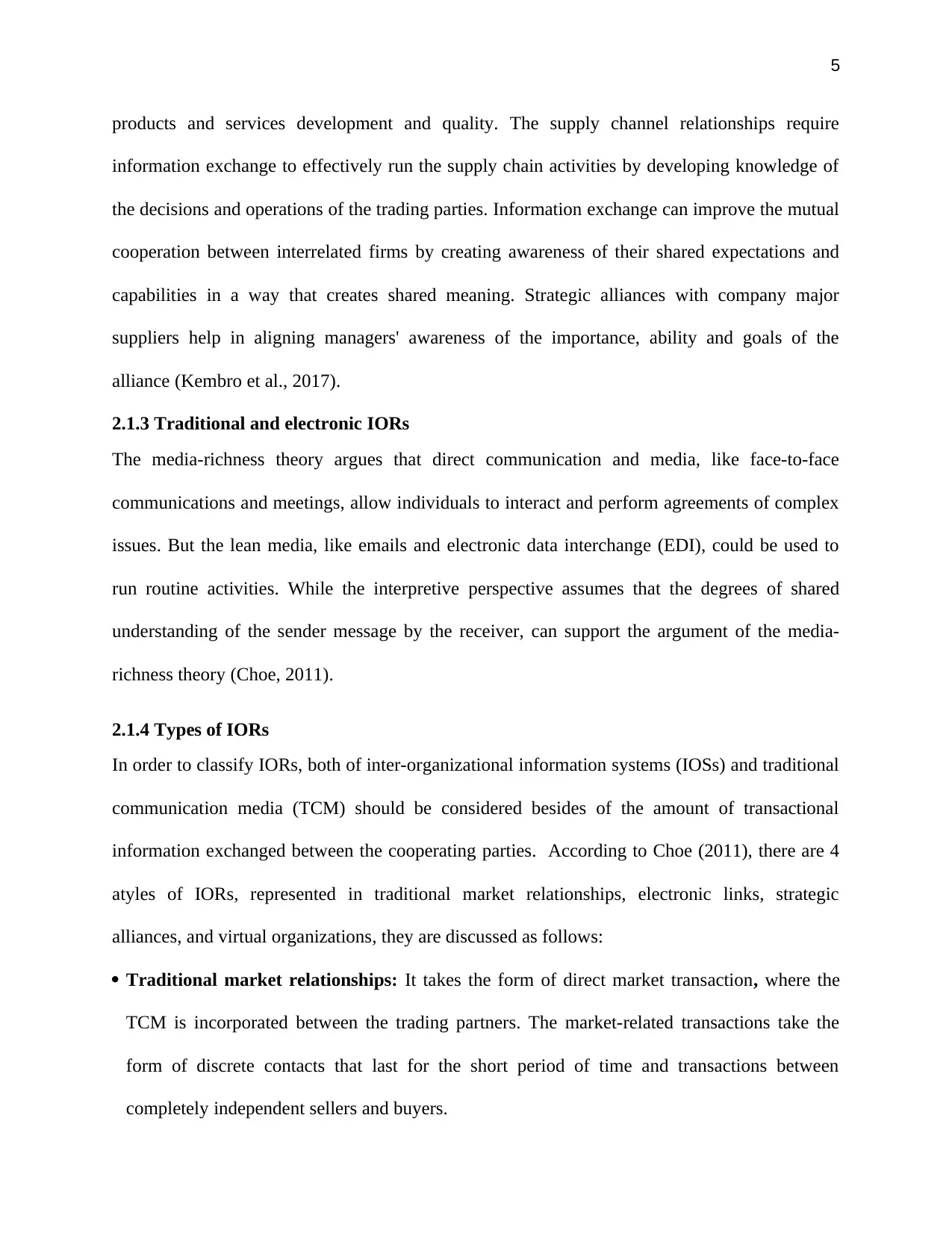
5
products and services development and quality. The supply channel relationships require
information exchange to effectively run the supply chain activities by developing knowledge of
the decisions and operations of the trading parties. Information exchange can improve the mutual
cooperation between interrelated firms by creating awareness of their shared expectations and
capabilities in a way that creates shared meaning. Strategic alliances with company major
suppliers help in aligning managers' awareness of the importance, ability and goals of the
alliance (Kembro et al., 2017).
2.1.3 Traditional and electronic IORs
The media-richness theory argues that direct communication and media, like face-to-face
communications and meetings, allow individuals to interact and perform agreements of complex
issues. But the lean media, like emails and electronic data interchange (EDI), could be used to
run routine activities. While the interpretive perspective assumes that the degrees of shared
understanding of the sender message by the receiver, can support the argument of the media-
richness theory (Choe, 2011).
2.1.4 Types of IORs
In order to classify IORs, both of inter-organizational information systems (IOSs) and traditional
communication media (TCM) should be considered besides of the amount of transactional
information exchanged between the cooperating parties. According to Choe (2011), there are 4
atyles of IORs, represented in traditional market relationships, electronic links, strategic
alliances, and virtual organizations, they are discussed as follows:
Traditional market relationships: It takes the form of direct market transaction, where the
TCM is incorporated between the trading partners. The market-related transactions take the
form of discrete contacts that last for the short period of time and transactions between
completely independent sellers and buyers.
products and services development and quality. The supply channel relationships require
information exchange to effectively run the supply chain activities by developing knowledge of
the decisions and operations of the trading parties. Information exchange can improve the mutual
cooperation between interrelated firms by creating awareness of their shared expectations and
capabilities in a way that creates shared meaning. Strategic alliances with company major
suppliers help in aligning managers' awareness of the importance, ability and goals of the
alliance (Kembro et al., 2017).
2.1.3 Traditional and electronic IORs
The media-richness theory argues that direct communication and media, like face-to-face
communications and meetings, allow individuals to interact and perform agreements of complex
issues. But the lean media, like emails and electronic data interchange (EDI), could be used to
run routine activities. While the interpretive perspective assumes that the degrees of shared
understanding of the sender message by the receiver, can support the argument of the media-
richness theory (Choe, 2011).
2.1.4 Types of IORs
In order to classify IORs, both of inter-organizational information systems (IOSs) and traditional
communication media (TCM) should be considered besides of the amount of transactional
information exchanged between the cooperating parties. According to Choe (2011), there are 4
atyles of IORs, represented in traditional market relationships, electronic links, strategic
alliances, and virtual organizations, they are discussed as follows:
Traditional market relationships: It takes the form of direct market transaction, where the
TCM is incorporated between the trading partners. The market-related transactions take the
form of discrete contacts that last for the short period of time and transactions between
completely independent sellers and buyers.
⊘ This is a preview!⊘
Do you want full access?
Subscribe today to unlock all pages.

Trusted by 1+ million students worldwide
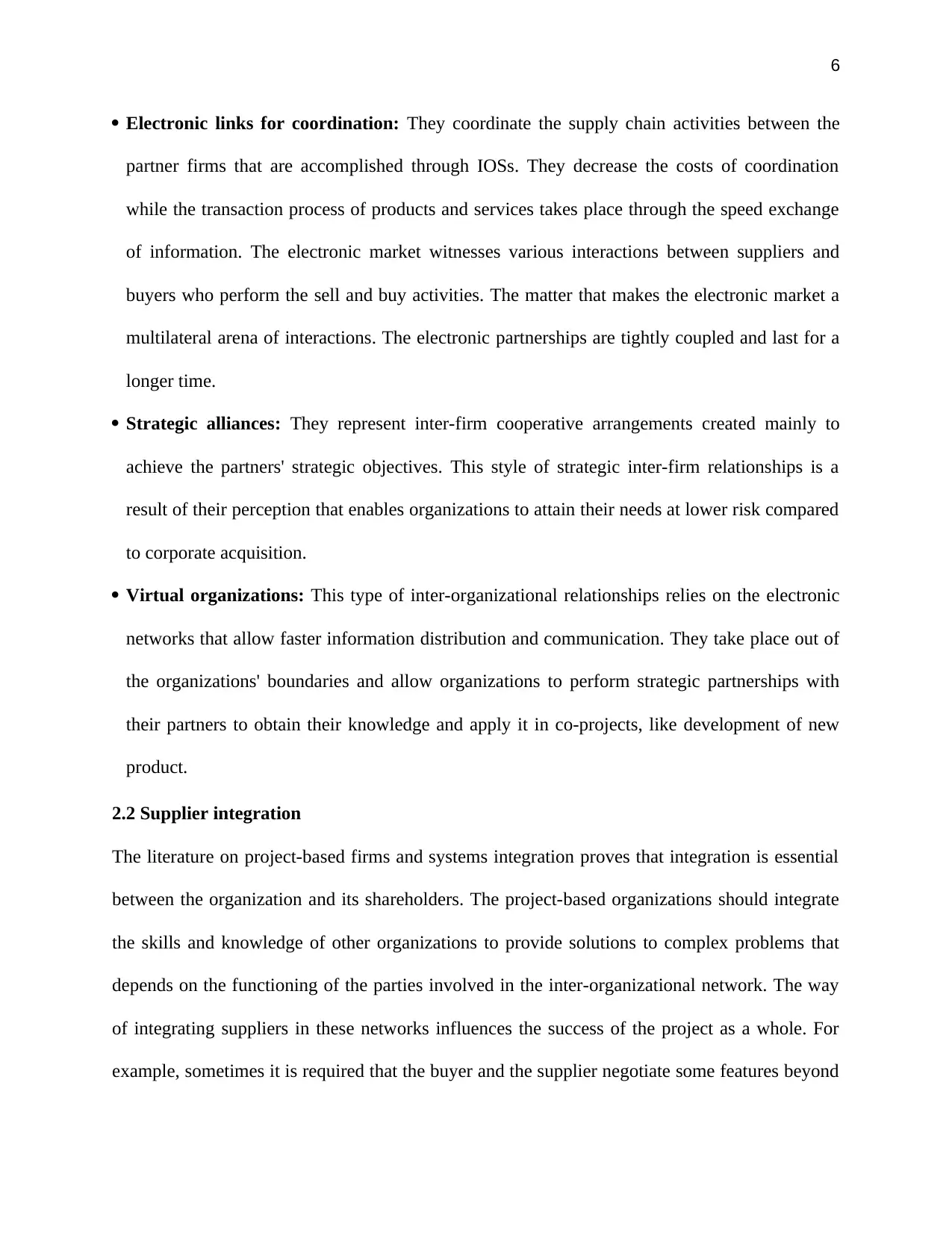
6
Electronic links for coordination: They coordinate the supply chain activities between the
partner firms that are accomplished through IOSs. They decrease the costs of coordination
while the transaction process of products and services takes place through the speed exchange
of information. The electronic market witnesses various interactions between suppliers and
buyers who perform the sell and buy activities. The matter that makes the electronic market a
multilateral arena of interactions. The electronic partnerships are tightly coupled and last for a
longer time.
Strategic alliances: They represent inter-firm cooperative arrangements created mainly to
achieve the partners' strategic objectives. This style of strategic inter-firm relationships is a
result of their perception that enables organizations to attain their needs at lower risk compared
to corporate acquisition.
Virtual organizations: This type of inter-organizational relationships relies on the electronic
networks that allow faster information distribution and communication. They take place out of
the organizations' boundaries and allow organizations to perform strategic partnerships with
their partners to obtain their knowledge and apply it in co-projects, like development of new
product.
2.2 Supplier integration
The literature on project-based firms and systems integration proves that integration is essential
between the organization and its shareholders. The project-based organizations should integrate
the skills and knowledge of other organizations to provide solutions to complex problems that
depends on the functioning of the parties involved in the inter-organizational network. The way
of integrating suppliers in these networks influences the success of the project as a whole. For
example, sometimes it is required that the buyer and the supplier negotiate some features beyond
Electronic links for coordination: They coordinate the supply chain activities between the
partner firms that are accomplished through IOSs. They decrease the costs of coordination
while the transaction process of products and services takes place through the speed exchange
of information. The electronic market witnesses various interactions between suppliers and
buyers who perform the sell and buy activities. The matter that makes the electronic market a
multilateral arena of interactions. The electronic partnerships are tightly coupled and last for a
longer time.
Strategic alliances: They represent inter-firm cooperative arrangements created mainly to
achieve the partners' strategic objectives. This style of strategic inter-firm relationships is a
result of their perception that enables organizations to attain their needs at lower risk compared
to corporate acquisition.
Virtual organizations: This type of inter-organizational relationships relies on the electronic
networks that allow faster information distribution and communication. They take place out of
the organizations' boundaries and allow organizations to perform strategic partnerships with
their partners to obtain their knowledge and apply it in co-projects, like development of new
product.
2.2 Supplier integration
The literature on project-based firms and systems integration proves that integration is essential
between the organization and its shareholders. The project-based organizations should integrate
the skills and knowledge of other organizations to provide solutions to complex problems that
depends on the functioning of the parties involved in the inter-organizational network. The way
of integrating suppliers in these networks influences the success of the project as a whole. For
example, sometimes it is required that the buyer and the supplier negotiate some features beyond
Paraphrase This Document
Need a fresh take? Get an instant paraphrase of this document with our AI Paraphraser
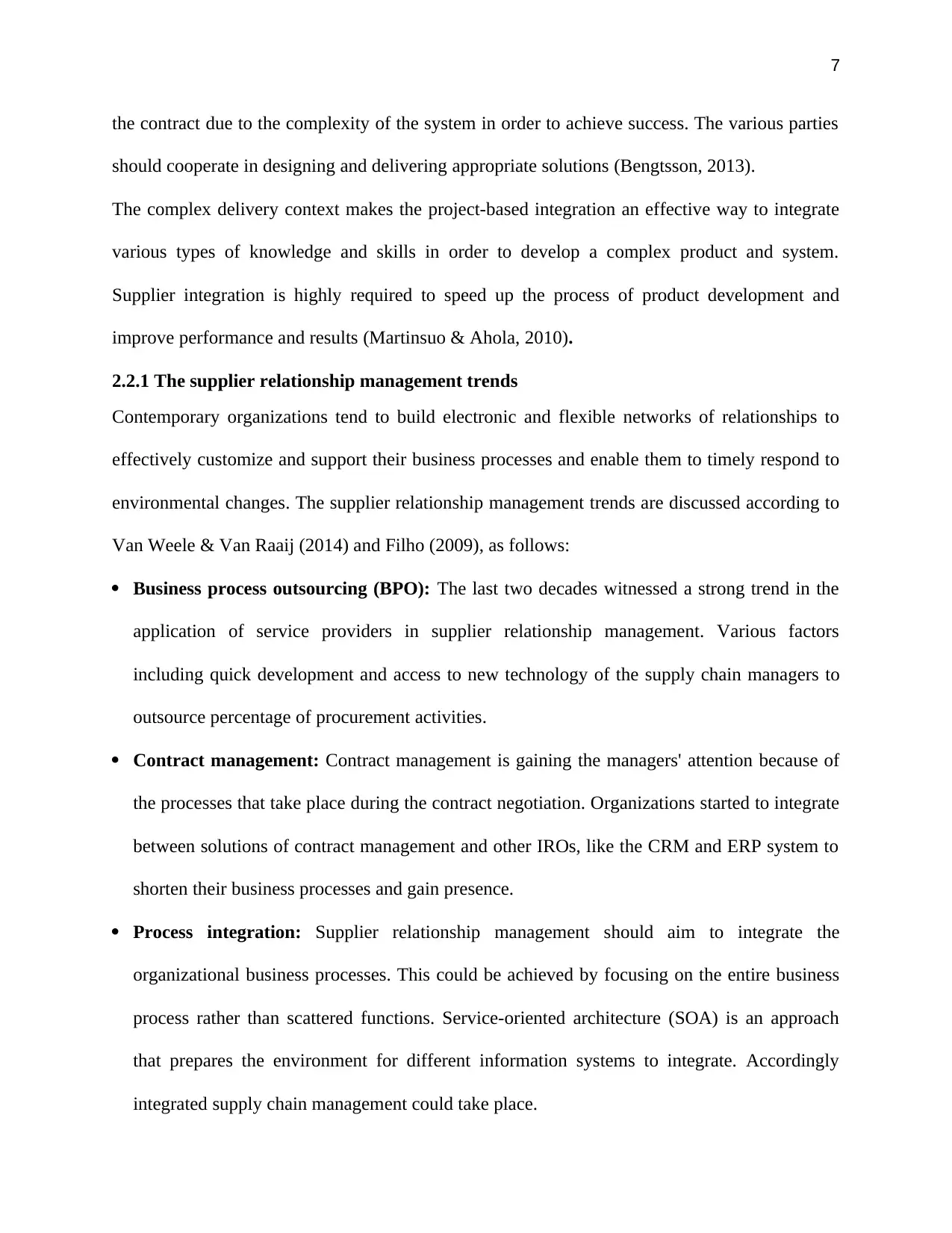
7
the contract due to the complexity of the system in order to achieve success. The various parties
should cooperate in designing and delivering appropriate solutions (Bengtsson, 2013).
The complex delivery context makes the project-based integration an effective way to integrate
various types of knowledge and skills in order to develop a complex product and system.
Supplier integration is highly required to speed up the process of product development and
improve performance and results (Martinsuo & Ahola, 2010).
2.2.1 The supplier relationship management trends
Contemporary organizations tend to build electronic and flexible networks of relationships to
effectively customize and support their business processes and enable them to timely respond to
environmental changes. The supplier relationship management trends are discussed according to
Van Weele & Van Raaij (2014) and Filho (2009), as follows:
Business process outsourcing (BPO): The last two decades witnessed a strong trend in the
application of service providers in supplier relationship management. Various factors
including quick development and access to new technology of the supply chain managers to
outsource percentage of procurement activities.
Contract management: Contract management is gaining the managers' attention because of
the processes that take place during the contract negotiation. Organizations started to integrate
between solutions of contract management and other IROs, like the CRM and ERP system to
shorten their business processes and gain presence.
Process integration: Supplier relationship management should aim to integrate the
organizational business processes. This could be achieved by focusing on the entire business
process rather than scattered functions. Service-oriented architecture (SOA) is an approach
that prepares the environment for different information systems to integrate. Accordingly
integrated supply chain management could take place.
the contract due to the complexity of the system in order to achieve success. The various parties
should cooperate in designing and delivering appropriate solutions (Bengtsson, 2013).
The complex delivery context makes the project-based integration an effective way to integrate
various types of knowledge and skills in order to develop a complex product and system.
Supplier integration is highly required to speed up the process of product development and
improve performance and results (Martinsuo & Ahola, 2010).
2.2.1 The supplier relationship management trends
Contemporary organizations tend to build electronic and flexible networks of relationships to
effectively customize and support their business processes and enable them to timely respond to
environmental changes. The supplier relationship management trends are discussed according to
Van Weele & Van Raaij (2014) and Filho (2009), as follows:
Business process outsourcing (BPO): The last two decades witnessed a strong trend in the
application of service providers in supplier relationship management. Various factors
including quick development and access to new technology of the supply chain managers to
outsource percentage of procurement activities.
Contract management: Contract management is gaining the managers' attention because of
the processes that take place during the contract negotiation. Organizations started to integrate
between solutions of contract management and other IROs, like the CRM and ERP system to
shorten their business processes and gain presence.
Process integration: Supplier relationship management should aim to integrate the
organizational business processes. This could be achieved by focusing on the entire business
process rather than scattered functions. Service-oriented architecture (SOA) is an approach
that prepares the environment for different information systems to integrate. Accordingly
integrated supply chain management could take place.
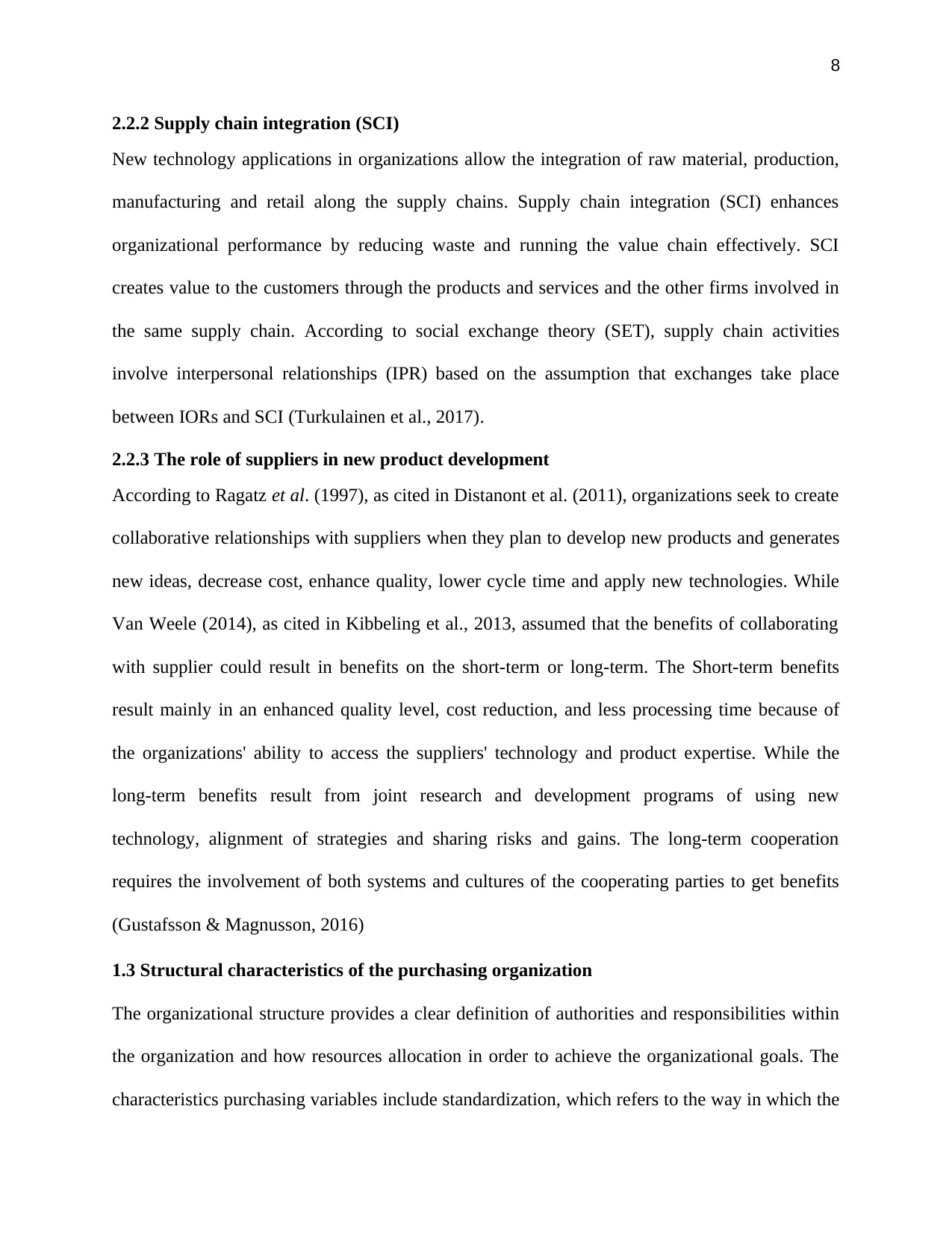
8
2.2.2 Supply chain integration (SCI)
New technology applications in organizations allow the integration of raw material, production,
manufacturing and retail along the supply chains. Supply chain integration (SCI) enhances
organizational performance by reducing waste and running the value chain effectively. SCI
creates value to the customers through the products and services and the other firms involved in
the same supply chain. According to social exchange theory (SET), supply chain activities
involve interpersonal relationships (IPR) based on the assumption that exchanges take place
between IORs and SCI (Turkulainen et al., 2017).
2.2.3 The role of suppliers in new product development
According to Ragatz et al. (1997), as cited in Distanont et al. (2011), organizations seek to create
collaborative relationships with suppliers when they plan to develop new products and generates
new ideas, decrease cost, enhance quality, lower cycle time and apply new technologies. While
Van Weele (2014), as cited in Kibbeling et al., 2013, assumed that the benefits of collaborating
with supplier could result in benefits on the short-term or long-term. The Short-term benefits
result mainly in an enhanced quality level, cost reduction, and less processing time because of
the organizations' ability to access the suppliers' technology and product expertise. While the
long-term benefits result from joint research and development programs of using new
technology, alignment of strategies and sharing risks and gains. The long-term cooperation
requires the involvement of both systems and cultures of the cooperating parties to get benefits
(Gustafsson & Magnusson, 2016)
1.3 Structural characteristics of the purchasing organization
The organizational structure provides a clear definition of authorities and responsibilities within
the organization and how resources allocation in order to achieve the organizational goals. The
characteristics purchasing variables include standardization, which refers to the way in which the
2.2.2 Supply chain integration (SCI)
New technology applications in organizations allow the integration of raw material, production,
manufacturing and retail along the supply chains. Supply chain integration (SCI) enhances
organizational performance by reducing waste and running the value chain effectively. SCI
creates value to the customers through the products and services and the other firms involved in
the same supply chain. According to social exchange theory (SET), supply chain activities
involve interpersonal relationships (IPR) based on the assumption that exchanges take place
between IORs and SCI (Turkulainen et al., 2017).
2.2.3 The role of suppliers in new product development
According to Ragatz et al. (1997), as cited in Distanont et al. (2011), organizations seek to create
collaborative relationships with suppliers when they plan to develop new products and generates
new ideas, decrease cost, enhance quality, lower cycle time and apply new technologies. While
Van Weele (2014), as cited in Kibbeling et al., 2013, assumed that the benefits of collaborating
with supplier could result in benefits on the short-term or long-term. The Short-term benefits
result mainly in an enhanced quality level, cost reduction, and less processing time because of
the organizations' ability to access the suppliers' technology and product expertise. While the
long-term benefits result from joint research and development programs of using new
technology, alignment of strategies and sharing risks and gains. The long-term cooperation
requires the involvement of both systems and cultures of the cooperating parties to get benefits
(Gustafsson & Magnusson, 2016)
1.3 Structural characteristics of the purchasing organization
The organizational structure provides a clear definition of authorities and responsibilities within
the organization and how resources allocation in order to achieve the organizational goals. The
characteristics purchasing variables include standardization, which refers to the way in which the
⊘ This is a preview!⊘
Do you want full access?
Subscribe today to unlock all pages.

Trusted by 1+ million students worldwide

9
organizational activities are defined. Materials standardization eliminates the differences
between similar products and increases the quantity of products types. Also, it reduces the level
of uncertainty and standardizes the purchasing process. Another characteristic is specialization, it
refers to labor division within the organization. They could be grouped based on their functions
or objects (Glock, 2011).
From the resource-based view (RBV) perspective, the IPRs are vital capabilities that are
processed by different organizations. RBV assumes that an organization can sustain its
competitive advantage by possessing and developing its rare, valuable and inimitable resources.
Accordingly, an organization can develop its relational activities, like trust, commitment and
power through IPRs and SCI over the long-term. IPRs can impact SCI through IORs that can
deploy the organization resources (Wang & Childerhouse, 2016).
1.3.1 Changing perspectives of procurement
Procurement practices are becoming more complex due to the dynamic and competitiveness of
markets. The increasing scope of outsourcing requires the procurement function to be involved in
the high level of the IRO. Suppliers are considered key strategic partners of the organizations,
they should understand the consumers' needs. Also, organization innovation requires great efforts
in procurement planning and information sharing. Strategic procurement on the long-term
involves senior management and specialists in marketing, operations, and purchasing (Hong &
Kwon, 2012; Song & Wang, 2010).
The current business practices are increasingly networked and information technology is highly
involved, enterprise resource planning (ERP) systems have replaced the traditional process
integration. ERP assist in managing a unified business view that involves all of the
organizational functions and business departments. Its database involves records, processed data,
and reports. This integrative view increases the need for interdepartmental cooperation.
organizational activities are defined. Materials standardization eliminates the differences
between similar products and increases the quantity of products types. Also, it reduces the level
of uncertainty and standardizes the purchasing process. Another characteristic is specialization, it
refers to labor division within the organization. They could be grouped based on their functions
or objects (Glock, 2011).
From the resource-based view (RBV) perspective, the IPRs are vital capabilities that are
processed by different organizations. RBV assumes that an organization can sustain its
competitive advantage by possessing and developing its rare, valuable and inimitable resources.
Accordingly, an organization can develop its relational activities, like trust, commitment and
power through IPRs and SCI over the long-term. IPRs can impact SCI through IORs that can
deploy the organization resources (Wang & Childerhouse, 2016).
1.3.1 Changing perspectives of procurement
Procurement practices are becoming more complex due to the dynamic and competitiveness of
markets. The increasing scope of outsourcing requires the procurement function to be involved in
the high level of the IRO. Suppliers are considered key strategic partners of the organizations,
they should understand the consumers' needs. Also, organization innovation requires great efforts
in procurement planning and information sharing. Strategic procurement on the long-term
involves senior management and specialists in marketing, operations, and purchasing (Hong &
Kwon, 2012; Song & Wang, 2010).
The current business practices are increasingly networked and information technology is highly
involved, enterprise resource planning (ERP) systems have replaced the traditional process
integration. ERP assist in managing a unified business view that involves all of the
organizational functions and business departments. Its database involves records, processed data,
and reports. This integrative view increases the need for interdepartmental cooperation.
Paraphrase This Document
Need a fresh take? Get an instant paraphrase of this document with our AI Paraphraser
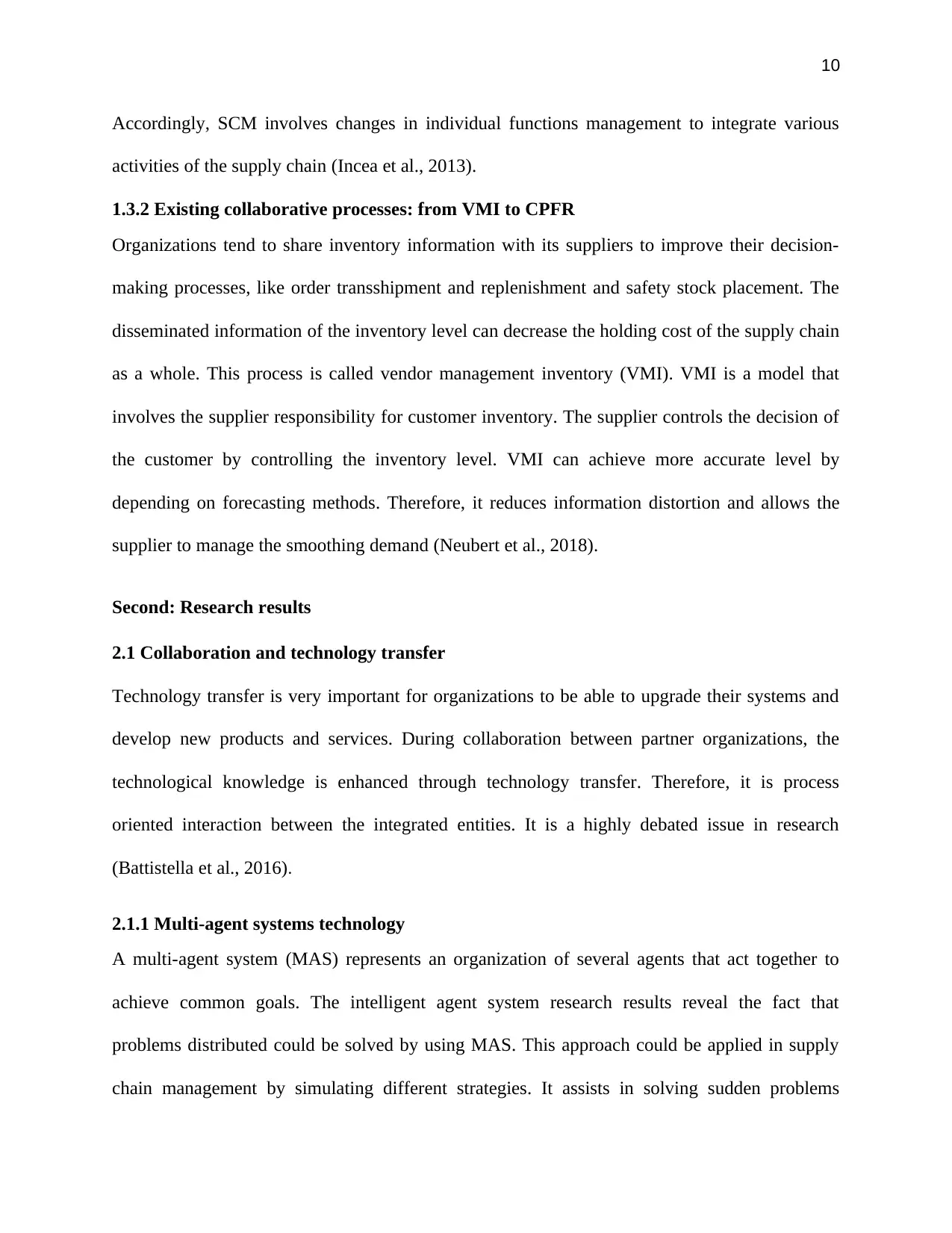
10
Accordingly, SCM involves changes in individual functions management to integrate various
activities of the supply chain (Incea et al., 2013).
1.3.2 Existing collaborative processes: from VMI to CPFR
Organizations tend to share inventory information with its suppliers to improve their decision-
making processes, like order transshipment and replenishment and safety stock placement. The
disseminated information of the inventory level can decrease the holding cost of the supply chain
as a whole. This process is called vendor management inventory (VMI). VMI is a model that
involves the supplier responsibility for customer inventory. The supplier controls the decision of
the customer by controlling the inventory level. VMI can achieve more accurate level by
depending on forecasting methods. Therefore, it reduces information distortion and allows the
supplier to manage the smoothing demand (Neubert et al., 2018).
Second: Research results
2.1 Collaboration and technology transfer
Technology transfer is very important for organizations to be able to upgrade their systems and
develop new products and services. During collaboration between partner organizations, the
technological knowledge is enhanced through technology transfer. Therefore, it is process
oriented interaction between the integrated entities. It is a highly debated issue in research
(Battistella et al., 2016).
2.1.1 Multi-agent systems technology
A multi-agent system (MAS) represents an organization of several agents that act together to
achieve common goals. The intelligent agent system research results reveal the fact that
problems distributed could be solved by using MAS. This approach could be applied in supply
chain management by simulating different strategies. It assists in solving sudden problems
Accordingly, SCM involves changes in individual functions management to integrate various
activities of the supply chain (Incea et al., 2013).
1.3.2 Existing collaborative processes: from VMI to CPFR
Organizations tend to share inventory information with its suppliers to improve their decision-
making processes, like order transshipment and replenishment and safety stock placement. The
disseminated information of the inventory level can decrease the holding cost of the supply chain
as a whole. This process is called vendor management inventory (VMI). VMI is a model that
involves the supplier responsibility for customer inventory. The supplier controls the decision of
the customer by controlling the inventory level. VMI can achieve more accurate level by
depending on forecasting methods. Therefore, it reduces information distortion and allows the
supplier to manage the smoothing demand (Neubert et al., 2018).
Second: Research results
2.1 Collaboration and technology transfer
Technology transfer is very important for organizations to be able to upgrade their systems and
develop new products and services. During collaboration between partner organizations, the
technological knowledge is enhanced through technology transfer. Therefore, it is process
oriented interaction between the integrated entities. It is a highly debated issue in research
(Battistella et al., 2016).
2.1.1 Multi-agent systems technology
A multi-agent system (MAS) represents an organization of several agents that act together to
achieve common goals. The intelligent agent system research results reveal the fact that
problems distributed could be solved by using MAS. This approach could be applied in supply
chain management by simulating different strategies. It assists in solving sudden problems
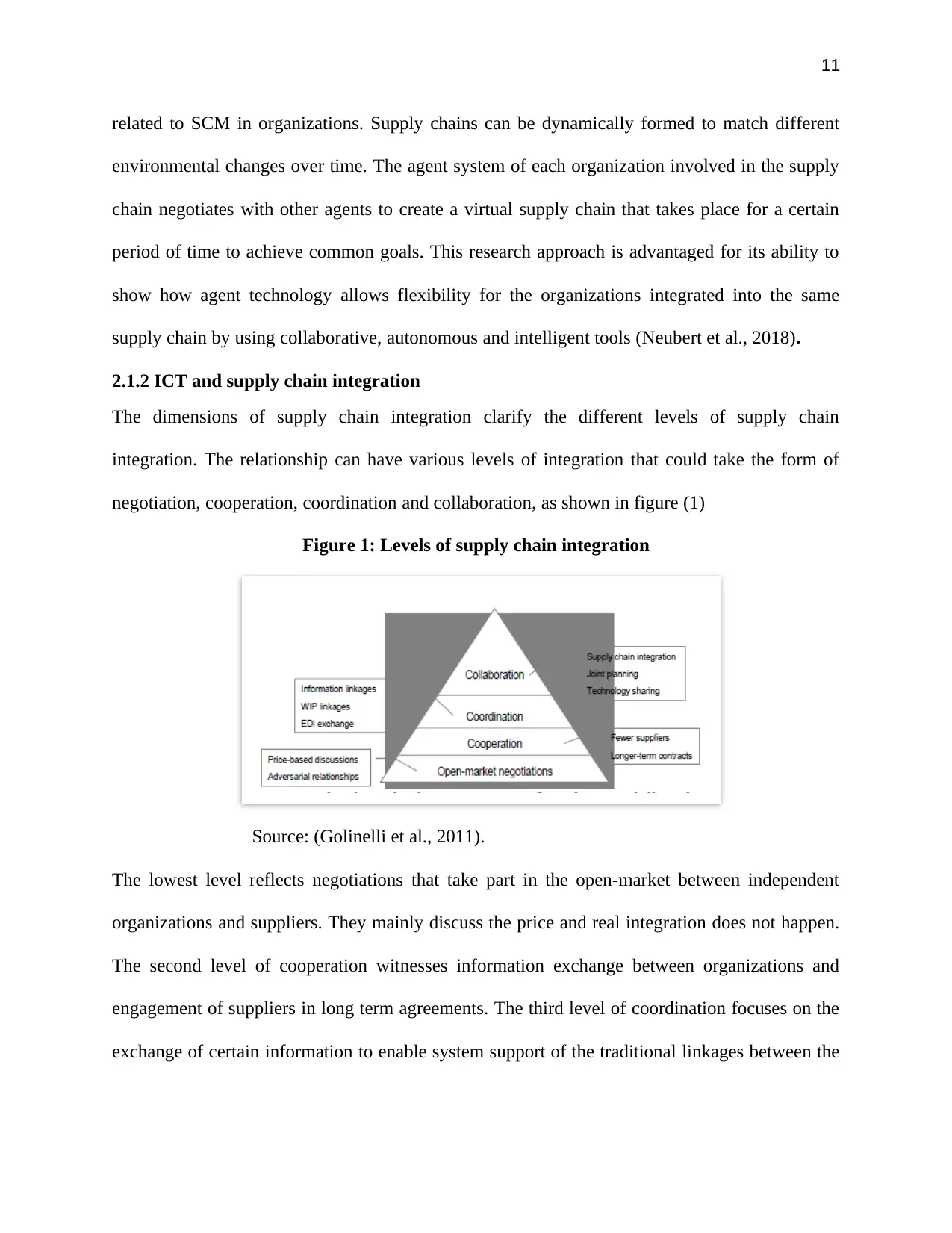
11
related to SCM in organizations. Supply chains can be dynamically formed to match different
environmental changes over time. The agent system of each organization involved in the supply
chain negotiates with other agents to create a virtual supply chain that takes place for a certain
period of time to achieve common goals. This research approach is advantaged for its ability to
show how agent technology allows flexibility for the organizations integrated into the same
supply chain by using collaborative, autonomous and intelligent tools (Neubert et al., 2018).
2.1.2 ICT and supply chain integration
The dimensions of supply chain integration clarify the different levels of supply chain
integration. The relationship can have various levels of integration that could take the form of
negotiation, cooperation, coordination and collaboration, as shown in figure (1)
Figure 1: Levels of supply chain integration
Source: (Golinelli et al., 2011).
The lowest level reflects negotiations that take part in the open-market between independent
organizations and suppliers. They mainly discuss the price and real integration does not happen.
The second level of cooperation witnesses information exchange between organizations and
engagement of suppliers in long term agreements. The third level of coordination focuses on the
exchange of certain information to enable system support of the traditional linkages between the
related to SCM in organizations. Supply chains can be dynamically formed to match different
environmental changes over time. The agent system of each organization involved in the supply
chain negotiates with other agents to create a virtual supply chain that takes place for a certain
period of time to achieve common goals. This research approach is advantaged for its ability to
show how agent technology allows flexibility for the organizations integrated into the same
supply chain by using collaborative, autonomous and intelligent tools (Neubert et al., 2018).
2.1.2 ICT and supply chain integration
The dimensions of supply chain integration clarify the different levels of supply chain
integration. The relationship can have various levels of integration that could take the form of
negotiation, cooperation, coordination and collaboration, as shown in figure (1)
Figure 1: Levels of supply chain integration
Source: (Golinelli et al., 2011).
The lowest level reflects negotiations that take part in the open-market between independent
organizations and suppliers. They mainly discuss the price and real integration does not happen.
The second level of cooperation witnesses information exchange between organizations and
engagement of suppliers in long term agreements. The third level of coordination focuses on the
exchange of certain information to enable system support of the traditional linkages between the
⊘ This is a preview!⊘
Do you want full access?
Subscribe today to unlock all pages.

Trusted by 1+ million students worldwide
1 out of 17
Related Documents
Your All-in-One AI-Powered Toolkit for Academic Success.
+13062052269
info@desklib.com
Available 24*7 on WhatsApp / Email
![[object Object]](/_next/static/media/star-bottom.7253800d.svg)
Unlock your academic potential
Copyright © 2020–2025 A2Z Services. All Rights Reserved. Developed and managed by ZUCOL.





